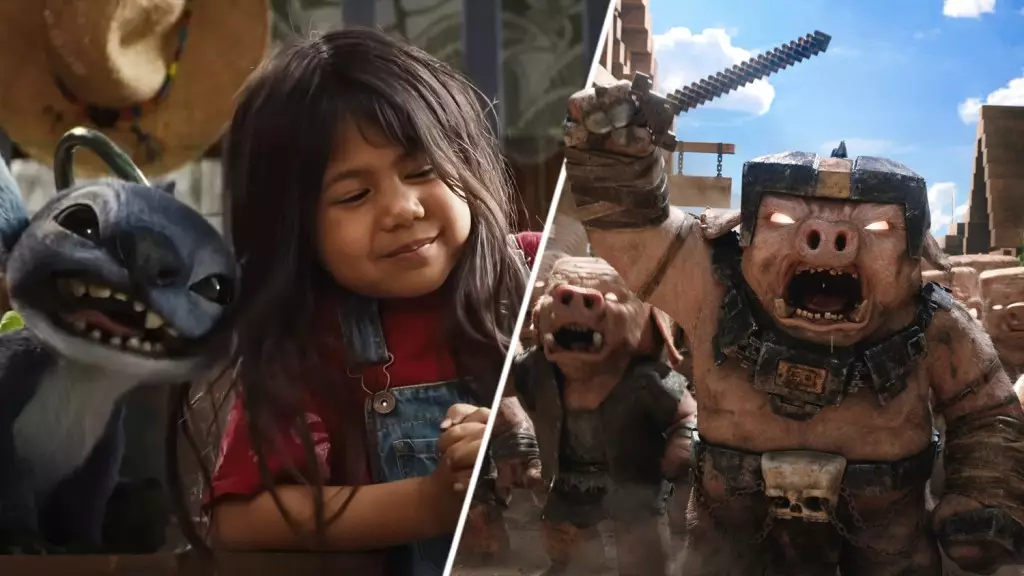In the landscape of contemporary cinema, the clear dominance of nostalgic properties underscores a significant industry shift. While Hollywood traditionally relied on big-budget spectacles, recent trends suggest an increasing dependence on established, beloved franchises that resonate deeply with audiences — especially female viewers — and provide a sense of familiarity amid economic and cultural uncertainty. Disney’s reimagining of “Lilo & Stitch,” which has now captivated audiences for six weeks and amassed over $400 million domestically, exemplifies this recalibration from novelty-driven blockbusters to properties rooted in fond memories. This isn’t mere coincidence; it’s a calculated move that leverages emotional investment, cultural affinity, and a strategic understanding of shifting audience preferences in an era of post-COVID recovery.
The success of such nostalgic titles challenges the traditional Hollywood narrative which often prioritizes innovation at all costs. These franchises offer reliability, predictable performance, and strong international appeal—factors that studios increasingly consider non-negotiable in a volatile financial environment. In many respects, it marks a return to core strengths: storytelling rooted in familiar characters and stories that hit emotional triggers. The international performance of “Lilo & Stitch” and “A Minecraft Movie” shows that nostalgia transcends borders, transforming cultural heritage and childhood memories into lucrative global assets.
Economic Resilience and Confidence in Theatrical Release Models
The post-pandemic era has witnessed a renaissance in theatrical confidence, driven in part by the remarkable performance of these nostalgic hits. Disney’s “Lilo & Stitch” achieved the second-largest four-day opening in history, trailing only “Black Panther,” which demonstrates not just recovery but burgeoning enthusiasm for theatrical experiences. This surge defies the trend of viewers turning to streaming services and indicates a resilience in the cinema-going habit—a necessary shift in perception for studios that had doubted the viability of theatrical beyond the long-accepted “event film” model.
Remarkably, these successes are occurring amidst ongoing strikes and economic uncertainties, which suggests not just resilience but a potential recalibration of Hollywood’s risk appetite. It reinforces the idea that audiences are craving quality content they can emotionally connect with on a cinematic scale, rather than simply seeking distraction through digital alone. For studios that bet correctly, there’s now an evident opportunity to reclaim box office dominance and solidify theatrical as the premier platform for high-value storytelling.
Narrative Dynamics and Strategic Content Focus
The focus on gender-diverse, family-oriented properties indicates a strategic shift toward capturing underserved markets. Titles like “Lilo & Stitch” and “Moana 2” with a significant female demographic—62% and 71% respectively—illustrate a nuanced understanding of contemporary consumer behavior. Disney’s targeting of these demographics underscores the recognition that financial success hinges sharply on inclusivity and relevance.
Furthermore, the international market indicates an evolving cultural landscape where familiar, heartwarming stories are more than just domestic hits—they are global phenomena. “Lilo & Stitch” attains record-breaking figures across multiple territories, including Latin America, where it ranks among the all-time top grossers. This widespread appeal is a testament to Disney’s mastery of balancing cultural nuances with universal themes—further bolstering the franchise’s status as a global powerhouse.
While some may argue that relying on nostalgia could stifle innovation, it’s undeniable that this approach signifies a pragmatic strategy. It reduces market risk and amplifies returns, especially at a time when studios need to justify their investments in theatrical releases amid streaming’s rise and ongoing industry disruptions.
Implications for Future Venture and Industry Strategy
As Disney and other studios monitor the rising dominance of these franchises, it’s clear that the future of Hollywood lies not merely in groundbreaking ideas, but in strategic exploitation of existing assets. The upcoming “Freakier Friday” sequel, with its nostalgic appeal and proven audience, exemplifies this concept. It’s a calculated risk—leveraging established characters and fan loyalty to ensure commercial viability.
The industry’s financial data reveals that franchises like Stitch continue to grow in retail sales, emphasizing the importance of brand strength beyond cinemas. The tenfold increase in Stitch’s retail revenue from 2019 to 2024 reflects a broader trend: successful franchises are multi-platform engines of sustained revenue and cultural relevance. This shift suggests that studio executives should prioritize franchise management, branding, and strategic content development rooted in emotional resonance and market confidence rather than solely pursuing innovation per se.
In sum, Hollywood’s current trajectory illustrates a complacency with proven formulas—yet beneath this reliance lies a pragmatic acknowledgment of changing audience expectations and economic realities. The seismic rise of nostalgic franchises signifies a pragmatic, audience-focused shift that could redefine industry standards for years to come.

